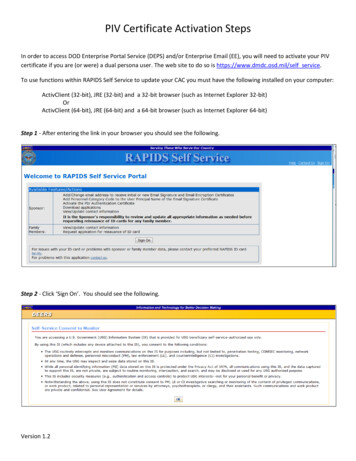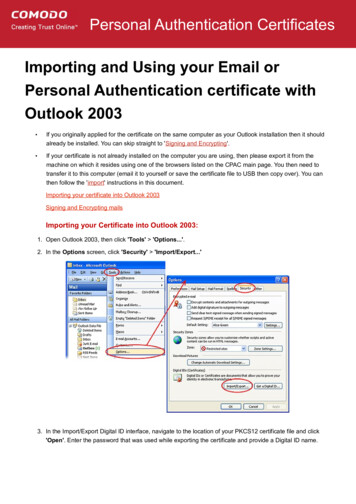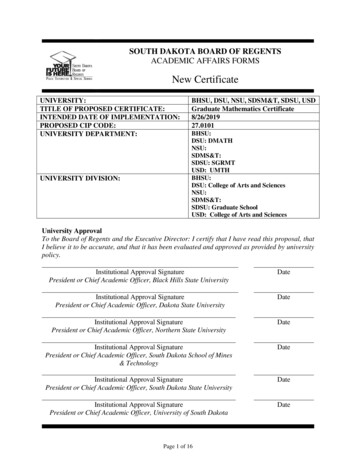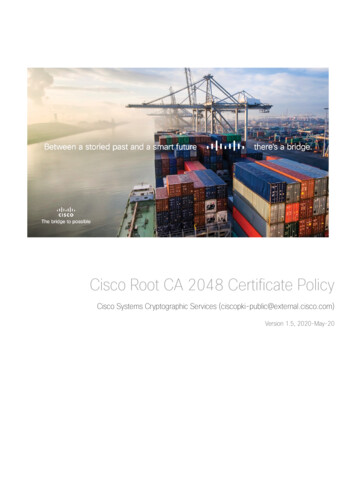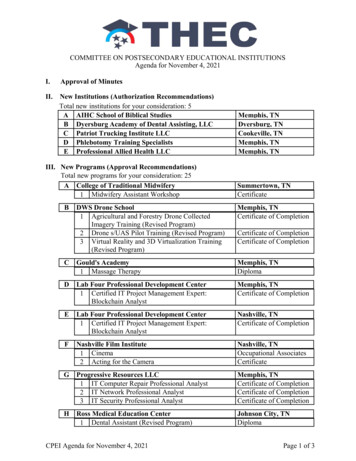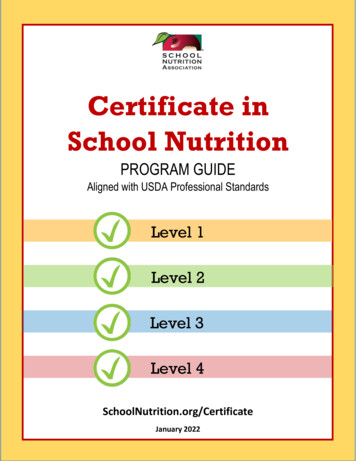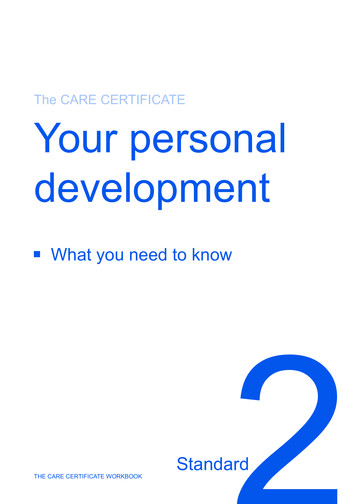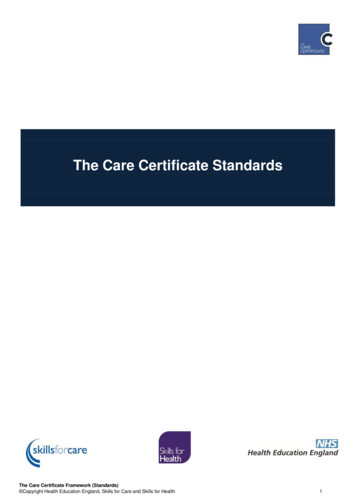
Transcription
The Care Certificate StandardsThe Care Certificate Framework (Standards) Copyright Health Education England, Skills for Care and Skills for Health1
What is the Care Certificate?The Care Certificate is an identified set of standards that health and social care workers adhere to in theirdaily working life. Designed with the non-regulated workforce1 in mind, the Care Certificate gives everyonethe confidence that these workers have the same introductory skills, knowledge and behaviours to providecompassionate, safe and high quality care and support.Regulated staff (e.g. Doctors, Nurses, Social Workers, Occupational Therapists) gain similar skills andknowledge within their professional training so they do not need to also achieve the Care Certificate.The Care Certificate: applies across health and social care; links to competences (National Occupational Standards) and units in qualifications; covers what is required to be caring; will equip workers with the fundamental skill they need to provide quality care; and gives them a basis from which they can further develop your knowledge and skills as their careerprogresses.What are the standards?The 15 standards in the Care Certificate are:1. Understand your role2. Your personal development3. Duty of care4. Equality and diversity5. Work in a person centred way6. Communication7. Privacy and dignity8. Fluids and nutrition9. Awareness of mental health, dementia and learning disability10. Safeguarding adults11. Safeguarding Children12. Basic Life Support13. Health and Safety14. Handling information15. Infection prevention and controlFull details of each standard will be covered in the following pages.1In Health roles may include: Assistant Practitioner, Care Assistant, Healthcare Support Worker, Maternity Support Worker,Nursing Assistant, Occupational Therapy Assistant, Physiotherapy Assistant, Radiography Assistant, Speech and Language TherapyAssistant, Senior Care Assistant. In Adult Social Care roles may include: Activities worker, Day Care Assistant, Day Care Officer,Domiciliary care worker, Home care worker, Nursing Assistant (in a nursing home or a hospice), Personal Assistants, ReablementAssistant, Residential Care Worker, Senior Home Care Worker, Support Worker. Other roles may be included whereachievement of all of the standards is possible.The Care Certificate Framework (Standards) Copyright Health Education England, Skills for Care and Skills for Health2
Is more information available?If you require information about how the Care Certificate is assessed and certified please see: Health Education England www.hee.nhs.uk or Skills for Care www.skillsforcare.org.uk or Skills for Health www.skillsforhealth.org.ukThe Care Certificate Framework (Standards) Copyright Health Education England, Skills for Care and Skills for Health3
Standard 1: Understand Your RoleOutcome – Thelearner is ableto:Assessment – The learner must:1.1a Describe their main duties and responsibilities1.1 Understandtheir own role1.1b List the standards and codes of conduct and practice that relate to their role1.1c Demonstrate that they are working in accordance with the agreed ways ofworking with their employer1.1d Explain how their previous experiences, attitudes and beliefs may affect theway they work1.2a Describe their employment rights and responsibilities1.2 Work inways that havebeen agreedwith theiremployer1.2b List the aims, objectives and values of the service in which they work1.2c Explain why it is important to work in ways that are agreed with their employer1.2d Demonstrate how to access full and up-to-date details of agreed ways ofworking that are relevant to their role1.2e Explain how and when to escalate any concerns they might have(whistleblowing)1.2f Explain why it is important to be honest and identify where errors may haveoccurred and to tell the appropriate person1.3a Describe their responsibilities to the individuals they support1.3 Understandworking1.3b Explain how a working relationship is different from a personal relationshiprelationshipsin health and1.3c Describe different working relationships in health and social care settingssocial care1.4a Explain why it is important to work in teams and in partnership with others.1.4 Work inpartnershipwith others1.4b Explain why it is important to work in partnership with key people, advocatesand others who are significant to an individual1.4c Demonstrate behaviours, attitudes and ways of working that can help improvepartnership working.1.4d Demonstrate how and when to access support and advice about: partnership workingresolving conflictsThe Care Certificate Framework (Standards) Copyright Health Education England, Skills for Care and Skills for Health4
Standard 2: Your personal developmentOutcome –The learner isable to:Assessment – The learner must:2.1a Identify sources of support for their own learning and development2.1 Agree apersonaldevelopmentplan2.1b Describe the process for agreeing a personal development plan and whoshould be involved2.1c Explain why feedback from others is important in helping to develop andimprove the way they work2.1d Contribute to drawing up own personal development plan2.1e Agree a personal development plan2.2 Developtheirknowledge,skills andunderstanding2.2a Describe the functional level of literacy, numeracy and communicationskills necessary to carry out their role2.2b Explain how to check their current level of literacy, numeracy andcommunication skills2.2c Describe how a learning activity has improved their own knowledge, skills andunderstanding2.2d Describe how reflecting on a situation has improved their own knowledge,skills and understanding2.2e Describe how feedback from others has developed their own knowledge, skillsand understanding2.2f Demonstrate how to measure their own knowledge, performance andunderstanding against relevant standards2.2g List the learning opportunities available to them and how they can use them toimprove the way they work2.2h Demonstrate how to record progress in relation to their personal development2.2i Explain why continuing professional development is importantThe Care Certificate Framework (Standards) Copyright Health Education England, Skills for Care and Skills for Health5
Standard 3: Duty of CareOutcome –The learner isable to:Assessment – The learner must:3.1a Define „duty of care’3.1Understandhow duty ofcarecontributes tosafe practice3.2Understandthe supportavailable foraddressingdilemmas thatmay ariseabout duty ofcare3.3 Deal withCommentsandcomplaints3.1b Describe how the duty of care affects their own work role3.2a Describe dilemmas that may arise between the duty of care and anindividual’s rights3.2b Explain what they must and must not do within their role in managing conflictsand dilemmas3.2c Explain where to get additional support and advice about how to resolve suchdilemmas3.3a Demonstrate how to respond to comments and complaints in line withlegislation and agreed ways of working3.3b Describe who to ask for advice and support in handling comments andcomplaints3.3c Explain the importance of learning from comments and complaints to improvethe quality of service3.4a Describe how to recognise adverse events, incidents, errors and near misses3.4 Deal withIncidents,errors andnear misses3.4b Explain what they must and must not do in relation to adverse events,incidents, errors and near misses3.4c List the legislation and agreed ways of working in relation to reporting anyadverse events, incidents, errors and near misses3.5a List the factors and difficult situations that may cause confrontation3.5 Deal withconfrontationand difficultsituations3.5b Describe how communication can be used to solve problems and reduce thelikelihood or impact of confrontation3.5c Describe how to assess and reduce risks in confrontational situations3.5d Demonstrate how and when to access support and advice about resolvingconflicts3.5e Explain the agreed ways of working for reporting any confrontationsThe Care Certificate Framework (Standards) Copyright Health Education England, Skills for Care and Skills for Health6
Standard 4: Equality and DiversityOutcome –The learner isable to:Assessment – The learner must:4.1a Explain what is meant by:4.1Understandtheimportance ofequality andinclusion diversityequalityinclusiondiscrimination4.1b Describe ways in which discrimination may deliberately or inadvertently occurin the work setting4.1c Explain how practices that support equality and inclusion reduce thelikelihood of discrimination4.2 Work in aninclusive way4.2a Identify which legislation and codes of practice relating to equality, diversityand discrimination apply to their own role4.2b Demonstrate interaction with individuals that respects their beliefs, culture,values and preferences4.2c Describe how to challenge discrimination in a way that encourages positivechange4.3 Accessinformation,advice andsupport aboutdiversity,equality andinclusion4.3a Identify a range of sources of information, advice and support aboutdiversity, equality and inclusion4.3b Describe how and when to access information, advice and support aboutdiversity, equality and inclusion4.3c Explain who to ask for advice and support about equality and inclusionThe Care Certificate Framework (Standards) Copyright Health Education England, Skills for Care and Skills for Health7
Standard 5: Work in a person centred wayOutcome –The learner isable to:5.1Understandpersoncentred valuesAssessment – The learner must:5.1a Describe how to put person-centred values into practice in their day-to-daywork5.1b Describe why it is important to work in a way that promotes person centredvalues when providing support to individuals5.1c Identify ways to promote dignity in their day-to-day work5.2Understandworking in apersoncentred way5.2a Describe the importance of finding out the history, preferences, wishes andneeds of the individual5.2b Explain why the changing needs of an individual must be reflected in theircare and/or support plan5.2c Explain the importance of supporting individuals to plan for their futurewellbeing and fulfilment, including end-of-life care5.3Demonstrateawareness ofthe individualsimmediateenvironmentand makechanges toaddressfactors thatmay becausingdiscomfort ordistress5.3a Take appropriate steps to remove or minimise the environmental factorscausing the discomfort or distress. This could include: LightingNoiseTemperatureUnpleasant odours5.3b Report any concerns they have to the relevant person. This could include: Senior member of staffCarerFamily member5.4a Raise any concerns directly with the individual concerned5.4 Makeothers awareof any actionsthey may beundertakingthat arecausingdiscomfort ordistress toindividuals5.4b Raise any concern with their supervisor/ manager5.4c Raise any concerns via other channels or systems e.g. at team meetingsThe Care Certificate Framework (Standards) Copyright Health Education England, Skills for Care and Skills for Health8
Outcome –The learner isable to:5.5 Supportindividuals tominimise painor discomfortAssessment – The learner must:5.5a Ensure that where individuals have restricted movement or mobility that theyare comfortable.5.5b Recognise the signs that an individual is in pain or discomfort. This couldinclude: Verbal reporting from the individualNon-verbal communicationChanges in behaviour5.5c Take appropriate action where there is pain or discomfort. This could include: Re-positioningReporting to a more senior member of staffGiving prescribed pain relief medicationEnsure equipment or medical devices are working properly or in the correctposition e.g. wheelchairs, prosthetics, catheter tubes5.5d Remove or minimise any environmental factors causing pain or discomfort.These could include: 5.6 Supportthe individualto maintaintheir identityand selfesteemWet or soiled clothing or bed linenPoorly positioned lightingNoise5.6a Explain how individual identity and self-esteem are linked to emotional andspiritual wellbeing5.6b Demonstrate that their own attitudes and behaviours promote emotional andspiritual wellbeing5.6c Support and encourage individuals own sense of identity and self-esteem5.6d Report any concerns about the individual’s emotional and spiritual wellbeingto the appropriate person. This could include: Senior member of staffCarerFamily member5.7a Demonstrate that their actions promote person centred values including:5.7 Supportthe individualusing personcentred values ignityrespectrightsThe Care Certificate Framework (Standards) Copyright Health Education England, Skills for Care and Skills for Health9
Standard 6: CommunicationOutcome –The learner isable to:Assessment – The learner must:6.1a Describe the different ways that people communicate6.1Understandtheimportance ofeffectivecommunicationat work6.2Understandhow to meetthecommunicationand languageneeds, wishesandpreferences ofindividuals6.1b Describe how communication affects relationships at work6.1c Describe why it is important to observe and be receptive to an individual’sreactions when communicating with them6.2a Describe how to establish an individual’s communication and languageneeds, wishes and preferences6.2b List a range of communication methods and styles that could help meet anindividual’s communication needs, wishes and preferences6.3a List barriers to effective communication6.3Understandhow topromoteeffectivecommunication6.3b Describe ways to reduce barriers to effective communication6.3c Describe how to check whether they (the HCSW/ASCW) havebeen understood6.3d Describe where to find information and support or services, to helpthem communicate more effectively6.4a Describe what confidentiality means in relation to their role6.4Understand theprinciples andpracticesrelating toconfidentiality6.4b List any legislation and agreed ways of working to maintain confidentialityin day-to-day communication6.4c Describe situations where information, normally considered to beconfidential, might need to be passed on6.4d Describe who they should ask for advice and support about confidentialityThe Care Certificate Framework (Standards) Copyright Health Education England, Skills for Care and Skills for Health10
Outcome –The learner isable to:Assessment – The learner must:6.5a Demonstrate the use appropriate verbal and non-verbal communication:6.5 Useappropriateverbal andnon-verbalcommunicationVerbal: Tone VolumeNonverbal: Position/ proximity Eye contact Body language Touch Signs Symbols and pictures Writing Objects of reference Human and technical aidsCommunication may take place: face to face by telephone or text by email, internet or social networks by written reports or letters6.6a Ensure that any communication aids/ technologies are:6.6 Support theuse ofappropriatecommunicationaids/technologies CleanWork properlyIn good repair6.6b Report any concerns about the communication aid/ technology tothe appropriate person. This could include: Senior member of staffCarerFamily memberThe Care Certificate Framework (Standards) Copyright Health Education England, Skills for Care and Skills for Health11
Standard 7: Privacy and DignityOutcome –The learner isable to:Assessment – The learner must:7.1a Describe what is meant by privacy and dignity7.1Understandthe principlesthat underpinprivacy anddignity in care7.2 Maintainthe privacyand dignity oftheindividual(s) intheir care7.1b List situations where an individual’s privacy and dignity could becompromised7.1c Describe how to maintain privacy and dignity in the work setting7.2a Demonstrate that their actions maintain the privacy of the individual. Thiscould include: Using appropriate volume to discuss the care and support of an individualDiscussing the individual’s care and support in a place where otherscannot overhear7.2b Demonstrate that the privacy and dignity of the individual is maintained at alltimes being in line with the person’s individual needs and preferences whenproviding personal care. This could include: Making sure doors, screens or curtains are in the correct positionGetting permission before entering someone’s personal spaceKnocking before entering the roomEnsuring any clothing, hospital gowns are positioned correctlyThe individual is positioned appropriately and the individual is notexposing any part of their body they would not want others to be able to see7.2c Explain why it is important not to disclose anything about the individual thatthey may wish to be kept private, unless it is appropriate to do so. This couldinclude: Health conditionSexual orientationPersonal historySocial circumstances7.2d Report any concerns they have to the relevant person. This could include: Senior member of staffCarerFamily memberThe Care Certificate Framework (Standards) Copyright Health Education England, Skills for Care and Skills for Health12
Outcome –The learner isable to:Assessment – The learner must:7.3a Describe ways of helping individuals to make informed choices7.3 Support anindividual’sright to makechoices7.3b Explain how risk assessment processes can be used to support the right ofindividuals to make their own decisions7.3c Explain why personal views must not influence an individual’s own choices ordecisions7.3d Describe why there may be times when they need to support an individual toquestion or challenge decisions made about them by others7.4a Demonstrate how to support individuals to make informed choices7.4 Supportindividuals inmakingchoices abouttheir care7.4b Ensure any risk assessment processes are used to support the right ofindividuals to make their own decisions7.4c Ensure their own personal views do not influence an individual’s own choicesor decisions7.4d Describe how to report any concerns they have to the relevant person. Thiscould include: 7.5Understandhow tosupport activeparticipationSenior member of staffCarerFamily member7.5a Describe the importance of how valuing people contributes to activeparticipation7.5b Explain how to enable individuals to make informed choices about their lives7.5c List other ways they can support active participation7.5d Describe the importance of enabling individuals to develop skills in self-careand to maintain their own network of friends within their community7.6 Supportthe individualin activeparticipationin their owncare7.6a Demonstrate that they can support the active participation of individuals intheir care7.6b Reflect on how their own personal views could restrict the individual’s abilityto actively participate in their care7.6c Report any concerns to the relevant person. This could include: Senior member of staff Carer Family memberThe Care Certificate Framework (Standards) Copyright Health Education England, Skills for Care and Skills for Health13
Standard 8: Fluids and nutritionOutcome –The learner isable to:8.1Understandthe principlesof hydration,nutrition andfood safetyAssessment – The learner must:8.1a Describe the importance of food safety, including hygiene, in the preparationand handling of food8.1b Explain the importance of good nutrition and hydration in maintaining healthand wellbeing8.1c List signs and symptoms of poor nutrition and hydration8.1d Explain how to promote adequate nutrition and hydration8.2 Supportindividuals tohave access tofluids inaccordancewith their planof care8.2a Ensure drinks are within reach of those that have restrictions on theirmovement/ mobility8.2b Ensure that drinks are refreshed on a regular basis8.2c Ensure that individuals are offered drinks in accordance with their plan of care8.2d Support and encourage individuals to drink in accordance with their plan ofcare8.2e Know how to report any concerns to the relevant person. This could include: 8.3 Supportindividuals tohave access tofood andnutrition inaccordancewith their planof careSenior member of staffCarerFamily member8.3a Ensure any nutritional products are within reach of those that have restrictionson their movement/ mobility8.3b Ensure food is provided at the appropriate temperature and in accordance withthe plan of care i.e. the individual is able to eat it8.3c Ensure that appropriate utensils are available to enable the individual to meettheir nutritional needs as independently as possible8.3d Support and encourage individuals to eat in accordance with their plan ofcare8.3e Know how to report any concerns to the relevant person. This could include: Senior member of staffCarerFamily memberThe Care Certificate Framework (Standards) Copyright Health Education England, Skills for Care and Skills for Health14
Standard 9: Awareness of mental health, dementia and learning disabilityOutcome – TheAssessment – The learner must:learner is able to:9.1a. List how someone may feel if they have:9.1 Understandthe needs andexperiences ofpeople withmental healthconditions,dementia orlearningdisabilities1. Mental health conditions such as:a. Psychosisb. Depressionc. Anxiety2. Dementia3. Learning DisabilitiesThe issues may be physical, social or psychological and will affect the individualin different ways.9.1b. Explain how these conditions may influence a person’s needs in relationto the care that they may require.9.1c. Explain why it is important to understand that the causes and supportneeds are different for people with mental health conditions, dementia andlearning disabilities.9.2 Understandtheimportance ofpromotingpositive healthandwellbeing foran individualwho may have amental healthcondition,dementia orlearningdisability9.3 Understandthe adjustmentswhich may benecessary in caredelivery relatingto an individualwho may have amental healthcondition,dementia orlearningdisability9.2a. Explain how positive attitudes towards those with mental healthconditions, dementia or learning disabilities will improve the care and supportthey receive9.2b. Describe the social model of disability and how it underpins positiveattitudes towards disability and involving people in their own care.9.3a. Describe what adjustments might need to be made to the way careis provided if someone has1. A mental health condition such as:a. Psychosisb. Depressionc. Anxiety2. Dementia3. Learning Disabilities9.3b. Describe how to report concerns associated with any unmet needs whichmay arise from mental health conditions, dementia or learning disability throughagreed ways of working.The Care Certificate Framework (Standards) Copyright Health Education England, Skills for Care and Skills for Health15
Outcome – Thelearner is ableto:9.4 Understandthe importanceof earlydetection ofmental healthconditions,dementia andlearningdisabilitiesAssessment – The learner must:9.4a. Explain why early detection of mental health needs, dementia or learningdisability is important9.4b. Give examples of how and why adjustments to care and support might needto be made when a mental health condition, dementia or learning disability isidentified.9.5a List the main requirements of legislation and policies that are designed to9.5 Understand promote the human rights, inclusion, equal life chances and citizenship oflegalindividuals with mental health conditions, dementia or learning disabilitiesframeworks,policy and9.5b Explain how the legislation and policies listed may affect the day to dayguidelinesexperiences of individuals with mental health needs, dementia or learningrelating todisabilities and their familiesmental healthconditions,dementia andlearningdisabilities9.6a Explain what is meant by the term “capacity”.9.6 Understandthe meaning ofmentalcapacity inrelation to howcare isprovided9.6b. Explain why it is important to assume that someone has capacity unless thereis evidence that they do not9.6c Explain what is meant by “consent”, and how it can change according to whatdecisions may need to be taken.9.6d Describe situations where an assessment of capacity might need to beundertaken and the meaning and significance of “advance statements” regardingfuture care.The Care Certificate Framework (Standards) Copyright Health Education England, Skills for Care and Skills for Health16
Standard 10: Safeguarding AdultsOutcome –The learner isable to:Assessment – The learner must:10.1a Explain the term safeguarding adults10.1Understandthe principlesofSafeguardingadults10.1b Explain their own role and responsibilities in safeguarding individuals10.1c List the main types of abuse10.1d Describe what constitutes harm10.1e Explain why an individual may be vulnerable to harm or abuse10.1f Describe what constitutes restrictive practices10.1g List the possible indicators of abuse10.hg Describe the nature and scope of harm to and abuse of adults at risk10.1i List a range of factors which have featured in adult abuse and neglect10.1j Demonstrate the importance of ensuring individuals are treated with dignityand respect when providing health and care services10.1k Describe where to get information and advice about their role andresponsibilities in preventing and protecting individuals from harm and abuse10.2 Reducethe likelihoodof abuse10.2a Describe how care environments can promote or undermine people's dignityand rights10.2b Explain the importance of individualised, person centred care10.2c Explain how to apply the basic principles of helping people to keepthemselves safe10.2d Explain the local arrangements for the implementation of multi-agencySafeguarding Adult’s policies and procedures10.2e List ways in which the likelihood of abuse can be reduced by managing riskand focusing on prevention10.2f Explain how a clear complaints procedure reduces the likelihood of abuse10.3 Respondto suspectedor disclosedabuse10.3a Explain what to do if abuse of an adult is suspected; including how to raiseconcerns within local whistleblowing policy proceduresThe Care Certificate Framework (Standards) Copyright Health Education England, Skills for Care and Skills for Health17
Outcome –The learner isable to:Assessment – The learner must:10.4a List relevant legislation, local and national policies and procedures which10.4 Protectrelate to safeguarding adultspeople fromharm and10.4b Explain the importance of sharing information with the relevant agenciesabuse – locallyand nationally 10.4c Describe the actions to take if they experience barriers in alerting or referringto relevant agenciesThe Care Certificate Framework (Standards) Copyright Health Education England, Skills for Care and Skills for Health18
Standard 11: Safeguarding ChildrenOutcome –The learner isable to:Assessment – The learner must:If they work in health: Meet the most up to date national minimum training11.1 Safeguard standards for Safeguarding Children at Level 1 as set out in the guidance issued bythe Intercollegiate Royal College of Paediatrics and Child Health.childrenIf they work in Social Care: Explain what they must do if they suspect a child,young person (met in any circumstances) is being abused or neglected.The Care Certificate Framework (Standards) Copyright Health Education England, Skills for Care and Skills for Health19
Standard 12: Basic Life SupportOutcome –The learner isable to:Assessment – The learner must:Be able to carry out basic life support.12.1 Providebasic lifesupportComplete practical Basic Life Support Training that meets the UK ResuscitationCouncil guidelines. If working with Adults in health and social care they will undertake training inadult basic life support.If working with Paediatric patients in health they will undertake training inpaediatric basic life support.If working with Newborn patients in health they will undertake training innewborn life support.Guidance: Most up to date Resuscitation Council Resuscitation GuidelinesCardiopulmonary Resuscitation – Standards for clinical practice andtraining Joint StatementThe Care Certificate Framework (Standards) Copyright Health Education England, Skills for Care and Skills for Health20
Standard 13: Health and safetyOutcome –The learner isable to:13.1Understandtheir ownresponsibilities,and theresponsibilitiesof others,relating tohealth andsafety in thework settingAssessment – The learner must:13.1a Identify legislation relating to general health and safety in a health or socialcare work setting13.1b Describe the main points of the health and safety policies and proceduresagreed with the employer13.1c Outline the main health and safety responsibilities of: selfthe employer or managerothers in the work setting13.1d List tasks relating to health and safety that should not be carried out withoutspecial training13.1e Explain how to access additional support and information relating to healthand safety13.1f Describe different types of accidents and sudden illness that may occur intheir own work setting13.2UnderstandRiskAssessment13.2a Explain why it is important to assess the health and safety risks posed byparticular work settings, situations or activities13.2b Describe how and when to report health and safety risks that they haveidentified13.3a Identify key pieces of legislation that relate to moving and assisting13.3 Move andassist safely13.3b List tasks relating to moving and assisting that they are not allowed to carryout until they are competent13.3c Demonstrate how to move and assist people and objects safely,maintaining the individual’s dignity, and in line with legislation and agreedways of working13.4Understandprocedures forresponding toaccidents andsudden illness13.4a List the different types of accidents and sudden illness that may occur inthe course of their work13.4b Describe the procedures to be followed if an accident or sudden illnessshould occur13.4c List the emergency first aid actions they are and are not allowed to carryoutThe Care Certificate Framework (Standards) Copyright Health Education England, Skills for Care and Skills for Health21
Outcome –The learner isable to:Assessment – The learner must:13.5a Describe the agreed ways of working in relation to medication
The Care Certificate is an identified set of standards that health and social care workers adhere to in their daily working life. . Assistant Practitioner, Care Assistant, Healthcare Support Worker, Maternity Support Worker, Nursing Assistant, Occupational Therapy Assistant, Physiotherapy Assistant, Radiography Assistant, Speech and Language .




